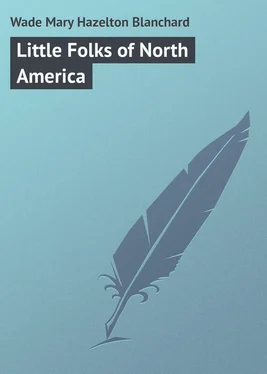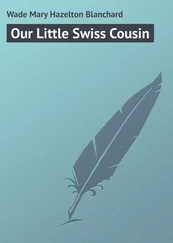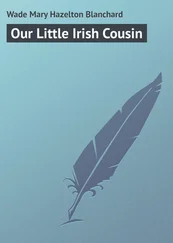Mary Wade - Little Folks of North America
Здесь есть возможность читать онлайн «Mary Wade - Little Folks of North America» — ознакомительный отрывок электронной книги совершенно бесплатно, а после прочтения отрывка купить полную версию. В некоторых случаях можно слушать аудио, скачать через торрент в формате fb2 и присутствует краткое содержание. Жанр: foreign_prose, foreign_language, на английском языке. Описание произведения, (предисловие) а так же отзывы посетителей доступны на портале библиотеки ЛибКат.
- Название:Little Folks of North America
- Автор:
- Жанр:
- Год:неизвестен
- ISBN:нет данных
- Рейтинг книги:4 / 5. Голосов: 1
-
Избранное:Добавить в избранное
- Отзывы:
-
Ваша оценка:
- 80
- 1
- 2
- 3
- 4
- 5
Little Folks of North America: краткое содержание, описание и аннотация
Предлагаем к чтению аннотацию, описание, краткое содержание или предисловие (зависит от того, что написал сам автор книги «Little Folks of North America»). Если вы не нашли необходимую информацию о книге — напишите в комментариях, мы постараемся отыскать её.
Little Folks of North America — читать онлайн ознакомительный отрывок
Ниже представлен текст книги, разбитый по страницам. Система сохранения места последней прочитанной страницы, позволяет с удобством читать онлайн бесплатно книгу «Little Folks of North America», без необходимости каждый раз заново искать на чём Вы остановились. Поставьте закладку, и сможете в любой момент перейти на страницу, на которой закончили чтение.
Интервал:
Закладка:
Sometimes in the early spring or fall the Eskimo children live in still different homes from their winter huts of stone or the summer tents. These are the snow houses, which the men can build very quickly.
If they are off on a long hunt, these snow houses are useful, for they are warm and comfortable in the worst storm or the coldest weather. Big blocks of solid snow are cut and piled up in the shape of a bee-hive. A small doorway is left open which can be filled with another snow-block when the people wish it. When the house is finished loose snow is sifted over it and every crack filled up so that the wind cannot make its way inside. The stone lamp is set up in the middle or at the side of the hut. A bench is made of snow and covered with furs, and the family are ready to go to housekeeping.
As soon as the Eskimo children see the birds flying in the springtime they begin to think of the fun they will have hunting for eggs. The boys get their bows and arrows ready at this time, for they will shoot dozens and dozens of the birds before the summer is over.
There are many kinds of these birds, most of which like to build their nests on the sides of steep cliffs along the shore. Best of all are the eider ducks with their soft and beautiful feathers. Shirts of eider-duck skin with the feathers worn next to the body are the best and warmest of all, both for the babies of the household and their fathers.
An Eskimo hunter will climb up the sides of the steepest cliff in his search for birds’ eggs. If he lose his foothold, he may fall a great distance and be dashed to pieces on the rocks below. But he does not seem to think of danger. His one idea is to get something good on which his family and himself may feast.
The boats of the Eskimos are called kayaks and are like no others in the world. The boys take many lessons before they can be trusted to help in making a kayak. It is long and narrow and has room for only one person. Its frame is of bone or wood and it is pointed at both ends. When it is finished, the boat-maker stretches over it a seal skin which his wife has tanned. It is an excellent covering, for the water cannot pass through it. In the middle of the top the man leaves an opening as large as his body is round. He steps inside and sits down, stretching his legs in front of him. Yes, the opening is of the right size; the water of the wildest sea cannot enter and sink the boat when once the Eskimo has fitted the rim around the bottom of his coat over the rim he has made about the opening in the skin covering. With his stout paddle he will dare to travel for miles over the rough sea.
The short summer-time is one long day, for the sun does not set. The children go to bed when they are tired and sleepy and get up when they please. They feast to their hearts’ content during this time, for there are usually fish and birds and eggs in plenty. Then, too, these children of the north go berrying and bring home many a dish of delicious black crow-berries.
The greatest dainty of all is the paunch of a reindeer’s stomach. It consists of the moss and shrubs the animal has eaten, and is a little acid. It is no wonder then that the Eskimos are fond of it, as they have neither bread nor vegetables, and no fruit except the berries they are able to pick during a few weeks out of each year.
As soon as the spring opens the older boys look forward to the hunt. Perhaps a herd of reindeer has been seen not far away, and the hunters start out over the fields still well-covered with snow to look for traces of them. They carry bows and arrows, also knives. They must not forget to take fur soles for their feet, too. As soon as they are within range of their game they will bind these soles under their kamiks so that the reindeer cannot hear them as they draw near.
Even now the herd may take fright while the hunters are still too far off to shoot. Then thud, thud, sound their feet as they scud away over the fields. But the hunters will not despair even then. They will give chase for hours together if it be necessary.
Sometimes the keen eyes of the Eskimos will find only prints on the snow to show that a herd of reindeer has been lately feeding there.
“We will stay here and watch for them to return,” they say to each other. Then they go to work to make a little fort of stones, behind which they sit down to watch and wait.
They may have to stay there a long time before the sound of reindeer hoofs is heard, but they are patient. They amuse each other with story-telling and the hours pass quickly.
At last a herd draws near. The antlers of these Arctic reindeer are broad and branching. They plant their short legs firmly on the ground as, with heads bent down, they search for moss beneath the snow. They seem to know just where to paw away the snow to find the food they love.
The right moment comes and the hunters send their arrows flying into the midst of the herd. One of the reindeer falls to the ground while the others dash wildly away.
When a number of animals have been killed in a hunt and there is too much meat to carry at once, some of it is buried under a pile of stones, so that the wolves and foxes cannot get it. Then the hunters trudge home for the dog team to help them.
You remember that Eric the Red went to live in Greenland before a white person had stepped on the mainland of North America. You also have learned that his followers lived in Greenland for a long time and then disappeared shortly after they met with the Eskimos.
From that time no more white people went to Greenland till the year 1585, when an Englishman named Davis sailed for many miles along its coast and visited among the Eskimos. Then he went away.
After his visit, there were no settlers from other lands for nearly a hundred years. Then a good minister in Denmark left home with his wife and children and went to a place in southwestern Greenland which he called God Havn or, Good Haven. Hans Egede, for this was the minister’s name, wished to teach the Eskimos the Christian religion.
He had hard work before him. A long time passed before he could understand the strange words of the Eskimo language and the only way he could teach the people was by the pictures he brought with him. Yet he stayed in Greenland for many years and his own children grew up with the little Eskimos for playmates.
Then Hans Egede’s wife died and he went back to Denmark. By this time, however, he had a grown-up son who loved the work his father had begun. He said, “I will remain here and keep on with your teaching.”
So he stayed. Other people from Denmark joined him, and now there are several settlements of Danes in Greenland. They have brought lumber with them with which to build their houses, as well as furniture and dishes from their old home across the sea. Even the sound of the piano may be heard now in this frozen land of the north. Tiny gardens have been dug where a few vegetables are raised each summer. Best of all, churches have been built where Eskimo children sit side by side with their fair-haired brothers and sisters of Denmark.
Once in a while a ship draws near bringing papers and letters, canned food and clothing from across the sea. It is a time of great excitement for the settlers. They have been getting ready for the coming of the ship for a long time, filling vessels with oil and fish, and packing the furs they have got in barter from the Eskimos. All these things are to be sold in other lands, besides many tons of cryolite which is very useful in making aluminum. The white settlers get it from a large mine and receive a good price for it, since Greenland and one other country are the only places in the world where it can be obtained.
Although the Eskimo children of southern Greenland have white playmates among them, yet above them in the north there is many a little village where people from other lands have never been seen or even heard of.
Читать дальшеИнтервал:
Закладка:
Похожие книги на «Little Folks of North America»
Представляем Вашему вниманию похожие книги на «Little Folks of North America» списком для выбора. Мы отобрали схожую по названию и смыслу литературу в надежде предоставить читателям больше вариантов отыскать новые, интересные, ещё непрочитанные произведения.
Обсуждение, отзывы о книге «Little Folks of North America» и просто собственные мнения читателей. Оставьте ваши комментарии, напишите, что Вы думаете о произведении, его смысле или главных героях. Укажите что конкретно понравилось, а что нет, и почему Вы так считаете.












